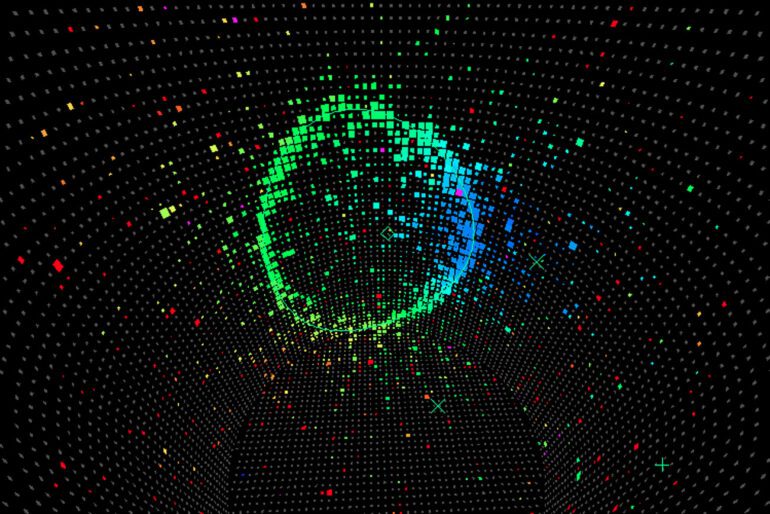TL;DR:
- Physicists grapple with sparse data while studying minute particles, impeding analysis.
- Sparse Convolutional Neural Networks (SCNNs) blend AI and data analysis for enhanced efficiency.
- SCNNs optimize resource utilization and accelerate data analysis, bridging computational advancements with particle physics.
- Benjamin Graham’s pioneering work in SCNNs laid the foundation for revolutionizing data analysis.
- Kazuhiro Terao’s application of SCNNs to neutrino studies promises accelerated insights into elusive particles.
Main AI News:
Efficiency in scientific exploration has always been a coveted goal. In the intricate realm of particle physics, where researchers spend substantial time deciphering complex data, efficiency takes on a whole new meaning. The challenge arises from the inherent “sparse” nature of data, where vast stretches of emptiness interlace the fabric of information. Imagine gazing at a photograph of the Eiffel Tower; a mere 0.02% showcases the iconic landmark’s iron structure, while the rest dissolves into vacant space.
For data-driven algorithms, scrutinizing these expanses of nothingness proves counterproductive, devouring precious computational resources without yielding substantial insights. The tiresome task of crunching numbers in sparse regions consumes as much processing power as analyzing consequential data. As a remedy, a pioneering convergence emerges: the fusion of artificial intelligence (AI) and a novel breed of machine learning known as sparse convolutional neural networks (SCNNs).
The Fusion of Power: AI and SCNNs
This heralds a transformative shift in the landscape, as computational advancements spearhead the evolution of data analysis in the field of physics. Researchers are placing their bets on this merger, envisioning streamlined analyses of intricate datasets and breakthrough discoveries on the horizon. As businesses optimize operations through AI integration, the scientific community takes its stride in adopting these innovations to unravel the mysteries of the universe.
A Glimpse into the Genesis
The seed of SCNNs was sown in 2012 by Benjamin Graham, a visionary student at the University of Warwick. Graham’s neural network, initially devised to decipher Chinese handwriting, redefined convolutional neural network (CNN) technology by targeting regions adorned with at least one pixel value. This ingenious modification allowed the exclusion of superfluous blank spaces within images, leading to a remarkable 2.61% error rate reduction. Graham’s innovation ignited a journey that culminated in the inception of the world’s first SCNN in 2017 during his tenure at Facebook’s AI Research division.
From the Lab to the Universe: Neutrino Exploration Enhanced
Fast-forward to the present day, where Kazuhiro Terao, a physicist at the SLAC National Accelerator Laboratory in California, embraces the SCNN paradigm in his research. Delving into the enigmatic realm of neutrinos, Terao navigates the elusive nature of these abundant yet hard-to-detect mass-bearing particles. The primary challenge lies in sparse data generated by neutrino interactions within detectors.
In 2019, Terao pioneered the application of SCNNs to analyze data from the Deep Underground Neutrino Experiment (DUNE). With its launch slated for 2026, DUNE is poised to become the globe’s largest neutrino physics experiment. As neutrinos journey from Chicago’s Fermilab to an underground facility in South Dakota, oscillations along this route hold key insights into the particles’ properties. SCNNs will play a pivotal role in deciphering the experiment’s findings.
Efficiency Redefined: The Promise of SCNNs
Terano sums it up succinctly, “With a sparse CNN, we analyze the entire image at once—and do it much faster.” This leap accelerates the identification of valuable data, expediting analysis without compromising accuracy. The realm of particle physics thrives on computational resources; streamlined analyses promise accelerated progress, aligning with the constraints of funding and time.
A New Era of Discovery
Traditionally, physicists have crafted bespoke algorithms for data analysis, ensuring precision aligned with their specific research objectives. Yet, the advent of potent SCNNs diminishes the necessity for such customizations in sparse data environments. As Harvard University physicist Carlos Arguelles-Delgado notes, “Computer science is often leading the way” in this computational evolution.
The echoes of this sentiment reverberate beyond physics, permeating diverse industries as AI’s prowess deepens. The rise of generative AI exemplified by tools like ChatGPT signifies a broader shift, propelling sectors toward unprecedented efficiency and insight. While SCNNs currently find their forte in physics, their trajectory foreshadows a future where AI’s transformative march shapes the landscape of knowledge acquisition and innovation.
Conclusion:
Incorporating AI-driven SCNNs into particle physics marks a turning point. The fusion of cutting-edge technology with intricate data analysis optimizes resource allocation and accelerates breakthroughs. As computational efficiency increasingly shapes industries, the marriage of AI and physics illustrates the broader implications of streamlined data analytics for various markets, setting a precedent for innovative convergence.

